formerly eScholarship Editions


|
|
|
|
Your request for similar items found 20 book(s). | Modify Search | Displaying 1 - 20 of 20 book(s) | |
| 1. | 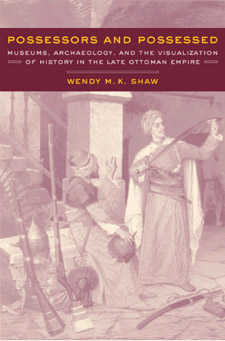 | Title: Possessors and possessed: museums, archaeology, and the visualization of history in the late Ottoman Empire Author: Shaw, Wendy M. K 1970- Published: University of California Press, 2003 Subjects: History | Middle Eastern Studies | Art | Middle Eastern History Publisher's Description: Possessors and Possessed analyzes how and why museums - characteristically Western institutions - emerged in the late-nineteenth-century Ottoman Empire. Shaw argues that, rather than directly emulating post-Enlightenment museums of Western Europe, Ottoman elites produced categories of collection and modes of display appropriate to framing a new identity for the empire in the modern era. In contrast to late-nineteenth-century Euro-American museums, which utilized organizational schema based on positivist notions of progress to organize exhibits of fine arts, Ottoman museums featured military spoils and antiquities long before they turned to the "Islamic" collections with which they might have been more readily associated. The development of these various modes of collection reflected shifting moments in Ottoman identity production. Shaw shows how Ottoman museums were able to use collection and exhibition as devices with which to weave counter-colonial narratives of identity for the Ottoman Empire. Impressive for both the scope and the depth of its research, Possessors and Possessed lays the groundwork for future inquiries into the development of museums outside of the Euro-American milieu. [brief] Similar Items |
| 2. | 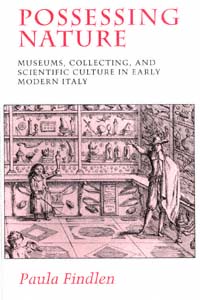 | Title: Possessing nature: museums, collecting, and scientific culture in early modern Italy Author: Findlen, Paula Published: University of California Press, 1994 Subjects: History | History and Philosophy of Science | European History | Renaissance History Publisher's Description: In 1500 few Europeans regarded nature as a subject worthy of inquiry. Yet fifty years later the first museums of natural history had appeared in Italy, dedicated to the marvels of nature. Italian patricians, their curiosity fueled by new voyages of exploration and the humanist rediscovery of nature, created vast collections as a means of knowing the world and used this knowledge to their greater glory.Drawing on extensive archives of visitors' books, letters, travel journals, memoirs, and pleas for patronage, Paula Findlen reconstructs the lost social world of Renaissance and Baroque museums. She follows the new study of natural history as it moved out of the universities and into sixteenth- and seventeenth-century scientific societies, religious orders, and princely courts. Findlen argues convincingly that natural history as a discipline blurred the border between the ancients and the moderns, between collecting in order to recover ancient wisdom and the development of new textual and experimental scholarship. Her vivid account reveals how the scientific revolution grew from the constant mediation between the old forms of knowledge and the new. [brief] Similar Items |
| 3. | 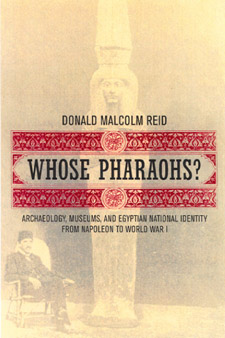 | Title: Whose pharaohs?: archaeology, museums, and Egyptian national identity from Napoleon to World War I Author: Reid, Donald M. (Donald Malcolm) 1940- Published: University of California Press, 2002 Subjects: History | Middle Eastern History | European History | Middle Eastern Studies | Classics | Art History Publisher's Description: Egypt's rich and celebrated ancient past has served many causes throughout history--in both Egypt and the West. Concentrating on the era from Napoleon's conquest and the discovery of the Rosetta Stone to the outbreak of World War I, this book examines the evolution of Egyptian archaeology in the context of Western imperialism and nascent Egyptian nationalism. Traditionally, histories of Egyptian archaeology have celebrated Western discoverers such as Champollion, Mariette, Maspero, and Petrie, while slighting Rifaa al-Tahtawi, Ahmad Kamal, and other Egyptians. This exceptionally well-illustrated and well-researched book writes Egyptians into the history of archaeology and museums in their own country and shows how changing perceptions of the past helped shape ideas of modern national identity. Drawing from rich archival sources in Egypt, the United Kingdom, and France, and from little-known Arabic publications, Reid discusses previously neglected topics in both scholarly Egyptology and the popular "Egyptomania" displayed in world's fairs and Orientalist painting and photography. He also examines the link between archaeology and the rise of the modern tourist industry. This richly detailed narrative discusses not only Western and Egyptian perceptions of pharaonic history and archaeology but also perceptions of Egypt's Greco-Roman, Coptic, and Islamic eras. Throughout this book, Reid demonstrates how the emergence of archaeology affected the interests and self-perceptions of modern Egyptians. In addition to uncovering a wealth of significant new material on the history of archaeology and museums in Egypt, Reid provides a fascinating window on questions of cultural heritage--how it is perceived, constructed, claimed, and contested. [brief] Similar Items |
| 4. | 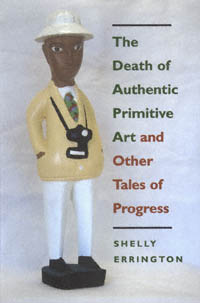 | Title: The death of authentic primitive art and other tales of progress Author: Errington, Shelly 1944- Published: University of California Press, 1998 Subjects: Anthropology | Cultural Anthropology | Art History | Architectural History | Art Theory Publisher's Description: In this lucid, witty, and forceful book, Shelly Errington argues that Primitive Art was invented as a new type of art object at the beginning of the twentieth century but that now, at the century's end, it has died a double but contradictory death. Authenticity and primitivism, both attacked by cultural critics, have died as concepts. At the same time, the penetration of nation-states, the tourist industry, and transnational corporations into regions that formerly produced these artifacts has severely reduced supplies of "primitive art," bringing about a second "death."Errington argues that the construction of the primitive in the nineteenth and twentieth centuries (and the kinds of objects chosen to exemplify it) must be understood as a product of discourses of progress - from the nineteenth-century European narrative of technological progress, to the twentieth-century narrative of modernism, to the late- twentieth-century narrative of the triumph of the free market. In Part One she charts a provocative argument ranging through the worlds of museums, art theorists, mail-order catalogs, boutiques, tourism, and world events, tracing a loosely historical account of the transformations of meanings of primitive art in this century. In Part Two she explores an eclectic collection of public sites in Mexico and Indonesia - a national museum of anthropology, a cultural theme park, an airport, and a ninth-century Buddhist monument (newly refurbished) - to show how the idea of the primitive can be used in the interests of promoting nationalism and economic development.Errington's dissection of discourses about progress and primitivism in the contemporary world is both a lively introduction to anthropological studies of art institutions and a dramatic new contribution to the growing field of cultural studies. [brief] Similar Items |
| 5. | 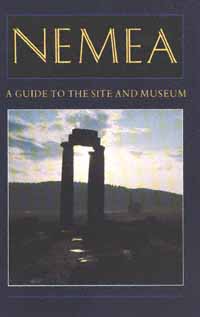 | Title: Nemea: a guide to the site and museum Author: Miller, Stephen G. (Stephen Gaylord) 1942- Published: University of California Press, 1989 Subjects: Classics | History | Archaeology | Ancient History Publisher's Description: In classical antiquity, beginning in 573 B.C., Nemea hosted international athletic competitions like those at Olympia, Delphi, and Isthmia; the games at the four sites constituted the Panhellenic cycle, and the victors were the most famous athletes of antiquity. Nemea was never a city-state but served as a religious and athletic festival center where the Greek world assembled every two years under a flag of truce.Since 1974, excavations sponsored by the University of California at Berkeley have revealed many details of Nemea's history, as well as evidence for the nature of the buildings and other facilities which were part of the festival center. These discoveries, together with smaller finds in the museum and ancient literary and epigraphic sources, form the basis of a new and sharply defined picture of the Nemean Games.This guidebook is an introduction to the history and physical remains of the festival center and a complement to detailed final publications on the excavation now being prepared. [brief] Similar Items |
| 6. | 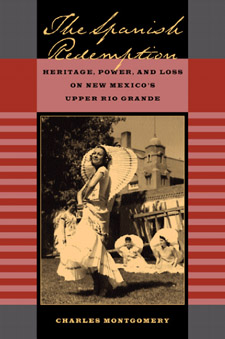 | Title: The Spanish redemption: heritage, power, and loss on New Mexico's upper Rio Grande Author: Montgomery, Charles H 1964- Published: University of California Press, 2002 Subjects: History | United States History | Latino Studies | California and the West Publisher's Description: Charles Montgomery's compelling narrative traces the history of the upper Rio Grande's modern Spanish heritage, showing how Anglos and Hispanos sought to redefine the region's social character by glorifying its Spanish colonial past. This readable book demonstrates that northern New Mexico's twentieth-century Spanish heritage owes as much to the coming of the Santa Fe Railroad in 1880 as to the first Spanish colonial campaign of 1598. As the railroad brought capital and migrants into the region, Anglos posed an unprecedented challenge to Hispano wealth and political power. Yet unlike their counterparts in California and Texas, the Anglo newcomers could not wholly displace their Spanish-speaking rivals. Nor could they segregate themselves or the upper Rio Grande from the image, well-known throughout the Southwest, of the disreputable Mexican. Instead, prominent Anglos and Hispanos found common cause in transcending the region's Mexican character. Turning to colonial symbols of the conquistador, the Franciscan missionary, and the humble Spanish settler, they recast northern New Mexico and its people. [brief] Similar Items |
| 7. | 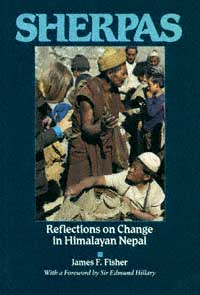 | Title: Sherpas: reflections on change in Himalayan Nepal Author: Fisher, James F Published: University of California Press, 1990 Subjects: Anthropology | Cultural Anthropology | South Asia Publisher's Description: James Fisher combines the strengths of technical anthropology, literary memoir, and striking photography in this telling study of rapid social change in Himalayan Nepal. The author first visited the Sherpas of Nepal when he accompanied Sir Edmund Hilary on the Himalayan Schoolhouse Expedition of 1964. Returning to the Everest region several times during the 1970s and 1980s, he discovered that the construction of the schools had far less impact than one of the by-products of their building: a short-take-off-and-landing airstrip. By reducing the time it took to travel between Kathmandu and the Everest region from a hike of several days to a 45-minute flight, the airstrip made a rapid increase in tourism possible. Beginning with his impressions of Sherpa society in pre-tourist days, Fisher traces the trajectory of contemporary Sherpa society reeling under the impact of modern education and mass tourism, and assesses the Sherpa's concerns for their future and how they believe these problems should be and eventually will be resolved. [brief] Similar Items |
| 8. | 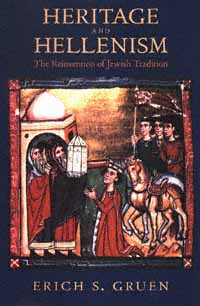 | Title: Heritage and hellenism: the reinvention of Jewish tradition Author: Gruen, Erich S Published: University of California Press, 1998 Subjects: Classics | Classical History | Classical Religions | Judaism | Ancient History | Jewish Studies Publisher's Description: The interaction of Jew and Greek in antiquity intrigues the imagination. Both civilizations boasted great traditions, their roots stretching back to legendary ancestors and divine sanction. In the wake of Alexander the Great's triumphant successes, Greeks and Macedonians came as conquerors and settled as ruling classes in the lands of the eastern Mediterranean. Hellenic culture, the culture of the ascendant classes in many of the cities of the Near East, held widespread attraction and appeal. Jews were certainly not immune. In this thoroughly researched, lucidly written work, Erich Gruen draws on a wide variety of literary and historical texts of the period to explore a central question: How did the Jews accommodate themselves to the larger cultural world of the Mediterranean while at the same time reasserting the character of their own heritage within it? Erich Gruen's work highlights Jewish creativity, ingenuity, and inventiveness, as the Jews engaged actively with the traditions of Hellas, adapting genres and transforming legends to articulate their own legacy in modes congenial to a Hellenistic setting. Drawing on a diverse array of texts composed in Greek by Jews over a broad period of time, Gruen explores works by Jewish historians, epic poets, tragic dramatists, writers of romance and novels, exegetes, philosophers, apocalyptic visionaries, and composers of fanciful fables - not to mention pseudonymous forgers and fabricators. In these works, Jewish writers reinvented their own past, offering us the best insights into Jewish self-perception in that era. [brief] Similar Items |
| 9. | 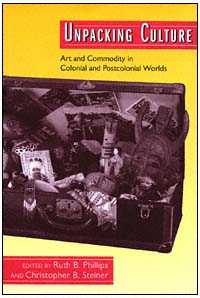 | Title: Unpacking culture: art and commodity in colonial and postcolonial worlds Author: Phillips, Ruth B. (Ruth Bliss) 1945- Published: University of California Press, 1999 Subjects: Anthropology | Social Science | Art History | Postcolonial Studies Publisher's Description: Tourist art production is a global phenomenon and is increasingly recognized as an important and authentic expression of indigenous visual traditions. These thoughtful, engaging essays provide a comparative perspective on the history, character, and impact of tourist art in colonized societies in three areas of the world: Africa, Oceania, and North America. Ranging broadly historically and geographically, Unpacking Culture is the first collection to bring together substantial case studies on this topic from around the world. [brief] Similar Items |
| 10. | 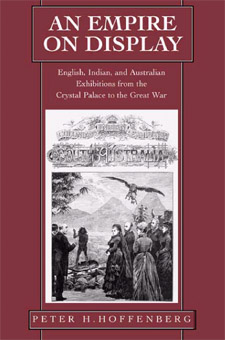 | Title: An empire on display: English, Indian, and Australian exhibitions from the Crystal Palace to the Great War Author: Hoffenberg, Peter H 1960- Published: University of California Press, 2001 Subjects: History | European History | Victorian History | Asian History | South Asia | Pacific Rim Studies | European Studies Publisher's Description: The grand exhibitions of the Victorian and Edwardian eras are the lens through which Peter Hoffenberg examines the economic, cultural, and social forces that helped define Britain and the British Empire. He focuses on major exhibitions in England, Australia, and India between the Great Exhibition of 1851 and the Festival of Empire sixty years later, taking special interest in the interactive nature of the exhibition experience, the long-term consequences for the participants and host societies, and the ways in which such popular gatherings revealed dissent as well as celebration. Hoffenberg shows how exhibitions shaped culture and society within and across borders in the transnational working of the British Empire. The exhibitions were central to establishing and developing a participatory imperial world, and each polity in that world provided distinctive information, visitors, and exhibits. Among the displays were commercial goods, working machines, and ethnographic scenes. Exhibits were intended to promote external commonwealth and internal nationalism. The imperial overlay did not erase significant differences but explained and used them in economic and cultural terms. The exhibitions in cities such as London, Sydney, and Calcutta were living and active public inventories of the Empire and its national political communities. The process of building and consuming such inventories persists today in the cultural bureaucracies, museums, and festivals of modern nation-states, the appeal to tradition and social order, and the actions of transnational bodies. [brief] Similar Items |
| 11. | 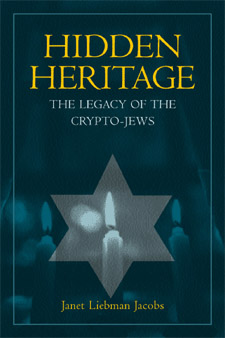 | Title: Hidden heritage: the legacy of the Crypto-Jews Author: Jacobs, Janet Liebman Published: University of California Press, 2002 Subjects: Religion | Latin American Studies | Cultural Anthropology | Jewish Studies | Sociology | Judaism Publisher's Description: This study of contemporary crypto-Jews - descendants of European Jews forced to convert to Christianity during the Spanish Inquisition - traces the group's history of clandestinely conducting their faith and their present-day efforts to reclaim their past. Janet Liebman Jacobs masterfully combines h . . . [more] Similar Items |
| 12. | 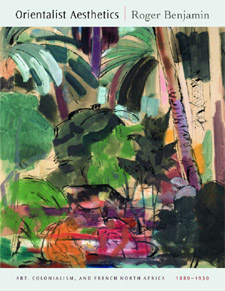 | Title: Orientalist aesthetics: art, colonialism, and French North Africa, 1880-1930 Author: Benjamin, Roger 1957- Published: University of California Press, 2003 Subjects: Art | Art History | French Studies Publisher's Description: Lavishly illustrated with exotic images ranging from Renoir's forgotten Algerian oeuvre to the abstract vision of Matisse's Morocco and beyond, this book is the first history of Orientalist art during the period of high modernism. Roger Benjamin, drawing on a decade of research in untapped archives, introduces many unfamiliar paintings, posters, miniatures, and panoramas and discovers an art movement closely bound to French colonial expansion. Orientalist Aesthetics approaches the visual culture of exoticism by ranging across the decorative arts, colonial museums, traveling scholarships, and art criticism in the Salons of Paris and Algiers. Benjamin's rediscovery of the important Society of French Orientalist Painters provides a critical context for understanding a lush body of work, including that of indigenous Algerian artists never before discussed in English. The painter-critic Eugène Fromentin tackled the unfamiliar atmospheric conditions of the desert, Etienne Dinet sought a more truthful mode of ethnographic painting by converting to Islam, and Mohammed Racim melded the Persian miniature with Western perspective. Benjamin considers armchair Orientalists concocting dreams from studio bric-à-brac, naturalists who spent years living in the oases of the Sahara, and Fauve and Cubist travelers who transposed the discoveries of the Parisian Salons to create decors of indigenous figures and tropical plants. The network that linked these artists with writers and museum curators was influenced by a complex web of tourism, rapid travel across the Mediterranean, and the march of modernity into a colonized culture. Orientalist Aesthetics shows how colonial policy affected aesthetics, how Europeans visualized cultural difference, and how indigenous artists in turn manipulated Western visual languages. [brief] Similar Items |
| 13. | 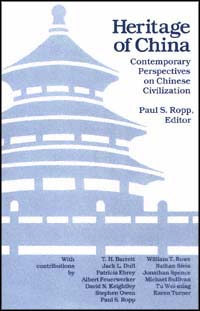 | Title: Heritage of China: contemporary perspectives on Chinese civilization Author: Ropp, Paul S 1944- Published: University of California Press, 1990 Subjects: History | China | Asian History Publisher's Description: The thirteen essays in this volume, all by experts in the field of Chinese studies, reflect the diversity of approaches scholars follow in the study of China's past. Together they reveal the depth and vitality of Chinese civilization and demonstrate how an understanding of traditional China can enri . . . [more] Similar Items |
| 14. | 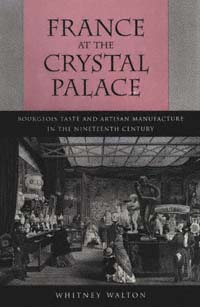 | Title: France at the Crystal Palace: bourgeois taste and artisan manufacture in the nineteenth century Author: Walton, Whitney Published: University of California Press, 1992 Subjects: History | European History | Women's Studies | French Studies Publisher's Description: Whitney Walton approaches the nineteenth-century French industrial development from a new perspective - that of consumption. She analyzes the French performance at the Crystal Palace Exhibition of 1851 to illustrate how bourgeois consumers influenced France's distinctive pattern of industrial development. She also demonstrates the importance of consumption and gender in class formation and reveals how women influenced industry in their role as consumers.Walton examines important consumer goods industries that have been rarely studied by historians, such as the manufacture of wallpaper, furniture, and bronze statues. Using archival sources on household possessions of the Parisian bourgeoisie as well as published works, she shows how consumers' taste for fashionable, artistic, well-made furnishings and apparel promoted a specialization unique to nineteenth-century France. [brief] Similar Items |
| 15. | 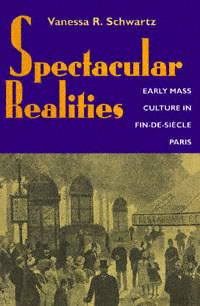 | Title: Spectacular realities: early mass culture in fin-de-siècle Paris Author: Schwartz, Vanessa R Published: University of California Press, 1998 Subjects: History | French Studies | European History | European Literature | Women's Studies | Film Publisher's Description: During the second half of the nineteenth century, Paris emerged as the entertainment capital of the world. The sparkling redesigned city fostered a culture of energetic crowd-pleasing and multi-sensory amusements that would apprehend and represent real life as spectacle.Vanessa R. Schwartz examines the explosive popularity of such phenomena as the boulevards, the mass press, public displays of corpses at the morgue, wax museums, panoramas, and early film. Drawing on a wide range of written and visual materials, including private and business archives, and working at the intersections of art history, literature, and cinema studies, Schwartz argues that "spectacular realities" are part of the foundation of modern mass society. She refutes the notion that modern life produced an unending parade of distractions leading to alienation, and instead suggests that crowds gathered not as dislocated spectators but as members of a new kind of crowd, one united in pleasure rather than protest. [brief] Similar Items |
| 16. | 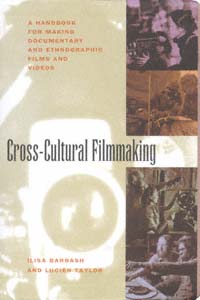 | Title: Cross-cultural filmmaking: a handbook for making documentary and ethnographic films and videos Author: Barbash, Ilisa 1959- Published: University of California Press, 1997 Subjects: Cinema and Performance Arts | Ethnic Studies | Photography Publisher's Description: This extraordinary handbook was inspired by the distinctive concerns of anthropologists and others who film people in the field. The authors cover the practical, technical, and theoretical aspects of filming, from fundraising to exhibition, in lucid and complete detail - information never before assembled in one place. The first section discusses filmmaking styles and the assumptions that frequently hide unacknowledged behind them, as well as the practical and ethical issues involved in moving from fieldwork to filmmaking. The second section concisely and clearly explains the technical aspects, including how to select and use equipment, how to shoot film and video, and the reasons for choosing one or the other, and how to record sound. Finally, the third section outlines the entire process of filmmaking: preproduction, production, postproduction, and distribution. Filled with useful illustrations and covering documentary and ethnographic filmmaking of all kinds, Cross-Cultural Filmmaking will be as essential to the anthropologist or independent documentarian on location as to the student in the classroom. [brief] Similar Items |
| 17. | 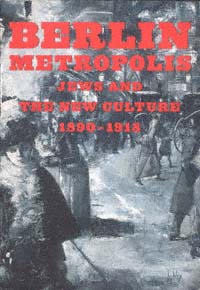 | Title: Berlin metropolis: Jews and the new culture, 1890-1918 Author: Bilski, Emily D 1956- Published: University of California Press, 2000 Subjects: Art | History | Jewish Studies | German Studies Publisher's Description: Between 1890 and 1918 the city of Berlin evolved into a commercial and industrial hub that also became an international center for radical new ideas in the visual, performing, and literary arts. Jews were key leaders in developing this unique cosmopolitan culture. Berlin Metropolis: Jews and the New Culture, 1890-1918 vividly documents the many ways that Jewish artists and entrepreneurs participated in this burst of artistic creativity and promoted the emergence of modernism on the international scene.The book and exhibition at The Jewish Museum highlight leading cultural figures such as Max Liebermann, a founder of the Berlin Secession, and Herwarth Walden, who founded Der Sturm; artists such as Ludwig Meidner and Jakob Steinhardt; pioneers of cabaret, theater, and film, including Max Reinhardt and Ernst Lubitsch; art dealers, publishers, and writers; and leading intellectual and political figures such as Martin Buber and Georg Simmel. These and other fascinating individuals are represented by more than 200 diverse objects: paintings, sculpture, drawings, prints, books, letters, posters, graphic arts, theater memorabilia, and film. The book includes eight essays by scholars of German and Jewish culture and art history that provide a truly interdisciplinary interpretation of the Berlin renaissance.The period represented in Berlin Metropolis was a time when Jews were traditionally restricted from participating in major areas of German public life such as the army, government, and the university. But by turning to the "alternative public spheres" characteristic of urban society - galleries, cafés, journals, theaters, cabarets - they emerged as innovative cultural leaders whose intellectual and artistic impact is still felt today.The exhibition, Berlin Metropolis: Jews and the New Culture, 1890-1918 , will be at The Jewish Museum, New York , from November 14, 1999, to March 5, 2000; and the Norton Museum of Art, West Palm Beach, Florida , from April 1 to June 11, 2000. [brief] Similar Items |
| 18. | 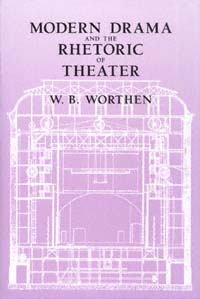 | Title: Modern drama and the rhetoric of theater Author: Worthen, William B 1955- Published: University of California Press, 1991 Subjects: Cinema and Performance Arts | Theatre | Rhetoric Publisher's Description: The history of drama is typically viewed as a series of inert "styles." Tracing British and American stage drama from the 1880s onward, W. B. Worthen instead sees drama as the interplay of text, stage production, and audience.How are audiences manipulated? What makes drama meaningful? Worthen identifies three rhetorical strategies that distinguish an O'Neill play from a Yeats, or these two from a Brecht. Where realistic theater relies on the "natural" qualities of the stage scene, poetic theater uses the poet's word, the text, to control performance. Modern political theater, by contrast, openly places the audience at the center of its rhetorical designs, and the drama of the postwar period is shown to develop a range of post-Brechtian practices that make the audience the subject of the play.Worthen's book deserves the attention of any literary critic or serious theatergoer interested in the relationship between modern drama and the spectator. [brief] Similar Items |
| 19. | 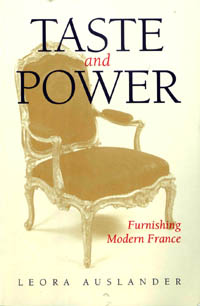 | Title: Taste and power: furnishing Modern France Author: Auslander, Leora Published: University of California Press, 1996 Subjects: History | European History | Art History | European Studies Publisher's Description: Louis XIV, regency, rococo, neoclassical, empire, art nouveau, and historicist pastiche: furniture styles march across French history as regimes rise and fall. In this extraordinary social history, Leora Auslander explores the changing meaning of furniture from the mid-seventeenth to the early twentieth century, revealing how the aesthetics of everyday life were as integral to political events as to economic and social transformations. Enriched by Auslander's experience as a cabinetmaker, this work demonstrates how furniture served to represent and even generate its makers' and consumers' identities. [brief] Similar Items |
| 20. | 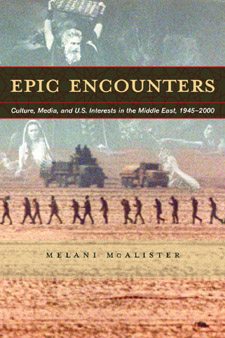 | Title: Epic encounters: culture, media, and U.S. interests in the Middle East, 1945-2000 Author: McAlister, Melani 1962- Published: University of California Press, 2001 Subjects: American Studies | United States History | Middle Eastern History | Popular Culture | Middle Eastern Studies | Ethnic Studies | Religion Publisher's Description: In the last half of the twentieth century, cultural products--from films and news reports to museum exhibits and novels--profoundly shaped ideas about the relationship between Americans and the Middle East. In this innovative book, Melani McAlister explores the cultural history of political interests, arguing that U.S. encounters with the Middle East were influenced by both the presence of oil and the religious symbolism of the region. McAlister's richly textured study shows how culture functions as a social and historical force in shaping politics and identity. She skillfully weaves lively and accessible readings of popular culture with a rigorous analysis of U.S. foreign policy and the domestic politics of race. McAlister begins by situating the postwar development of U.S.-Middle East relations, including the rise of anticolonialism and the establishment of the state of Israel. Subsequent chapters consider specific events and cultural texts such as the epic film The Ten Commandments, the King Tut museum exhibit, writings from the Black arts movement, the U.S.-Iranian hostage crisis, and the 1990-1991 Gulf War. In each of these cases, McAlister demonstrates how representations of the Middle East have been a site of struggle over both the nature of U.S. foreign policy and the construction of race, religion, and gender within the United States. Truly interdisciplinary, this work will appeal to a wide audience as it illuminates the significant intersection of culture and politics that is at the heart of both nationalism and globalization. [brief] Similar Items |